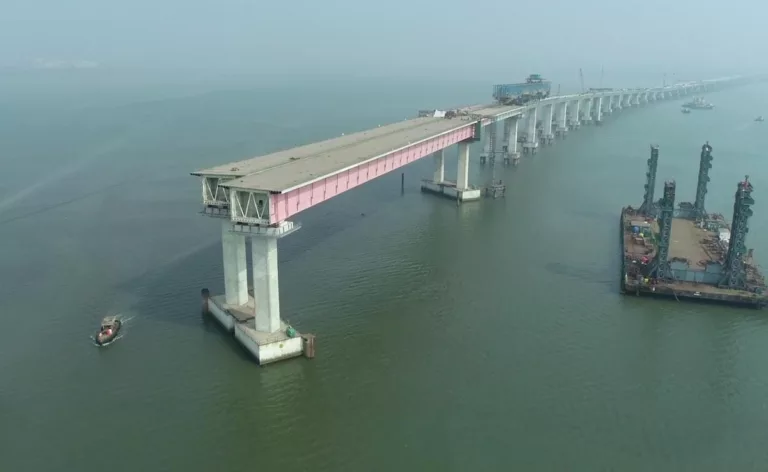The Mumbai Trans Harbour Link (MTHL) emerges as a beacon of innovation and engineering prowess, redefining the landscape of connectivity in India. In a city characterized by dynamic urban challenges, the MTHL stands as a testament to forward-thinking design and meticulous execution. With seismic resilience, advanced materials, and a commitment to environmental conservation, the bridge promises not only to meet immediate transportation needs but also to serve as a catalyst for economic growth and regional connectivity. This comprehensive exploration unveils the key features that make the MTHL a monumental stride in urban development, setting a new standard for transformative infrastructure projects.

Mumbai Trans Harbour Link (MTHL) Design Features:
- Earthquake Resistance:
- Equipped with 254 seismic isolation bearings for independent movement during earthquakes.
- Ductile concrete piers designed to bend without breaking, enhancing resilience.
- High-Performance Concrete:
- Specially formulated concrete to resist seawater corrosion and extreme weather conditions.
- Minimizes heat generation, reducing the risk of cracks and ensuring longevity.
- Precast Segments:
- Deck composed of precast concrete segments for faster, high-quality construction.
- Minimizes environmental disruption and maintains construction standards.
- Caisson Foundations:
- Provides stability in the marine environment.
- Crucial for maintaining the bridge’s integrity amidst challenging sea conditions.
- Underwater Construction:
- Complex underwater operations using skilled divers and remotely operated vehicles (ROVs).
- Orthotropic Steel Bridge Decks:
- 70 orthotropic decks, weighing 84,000 tons, enable longer spans without traditional girders.
- High-strength steel sourced from advanced countries like Japan for durability.
- Prefabrication and Transport:
- 97% of the bridge structure prefabricated in countries with advanced engineering capabilities.
- Components transported to Karanja Port for final assembly, showcasing global collaboration.
- Innovative Construction Techniques:
- Introduction of Reverse Circulation Drilling (RCD) to minimize disturbance to migratory birds.
- Automated girder launching system for laying the bridge’s foundation, improving efficiency.
- Workforce and Expertise:
- Generated 115,419 man-months of employment, involving over 14,000 workers.
- Expertise drawn from consultants in 10 different countries for diverse perspectives.
- Noise and Vision Barriers:
- Implemented along a 6 km stretch to obstruct views and safeguard bird habitats.
- Declared a “silent zone” in specific areas to minimize noise impact on migratory birds.
- Bird Watching Platform:
- Temporary access bridge repurposed into a 5.6 km bird-watching platform.
- Supports environmental sustainability and reduces demolition costs.
- Traffic Management and Safety Measures:
- Advanced Traffic Management System (ATMS) for real-time monitoring.
- Prohibition of entry for certain vehicles and speed limits for safety.
- Security Technology Adaptation:
- Comprehensive Surveillance System, Speed Violation Detection System, and Emergency Calling Boxes.
- Enhances safety, communication, and incident management.
- Stone Matrix Asphalt (SMA) for Sustainability:
- Used for paving, offering high resistance, reduced noise, and improved road surface visibility.
- 100% recyclable, aligning with environmental preservation goals.
- Eco-Friendly Lighting Design:
- 1,212 special light poles designed to minimize luminous spill onto the sea.
- Recognized with a sustainability certificate from the Bombay Natural History Society.

Importance of MTHL:
- Critical infrastructure for enhanced connectivity between Mumbai, Navi Mumbai, and Goa.
- Longest sea bridge in India, reducing travel time, congestion, and fostering economic activities.
- Vital for regional connectivity, opening avenues for trade, tourism, and cultural exchange.
Conclusion:
As the longest sea bridge in India, the Mumbai Trans Harbour Link signifies more than just a transportation solution; it is a symbol of resilience, sustainability, and progress. From earthquake resistance to eco-friendly lighting, the meticulous design and construction showcase a commitment to innovation and environmental responsibility. Beyond its physical dimensions, the MTHL’s role in generating employment, fostering international collaboration, and connecting Mumbai, Navi Mumbai, and Goa underscores its broader impact on regional development. With its integration of cutting-edge technology and a dedication to balancing growth with conservation, the MTHL not only meets the immediate needs of the bustling metropolis but also sets a visionary precedent for the future of urban infrastructure in India.




